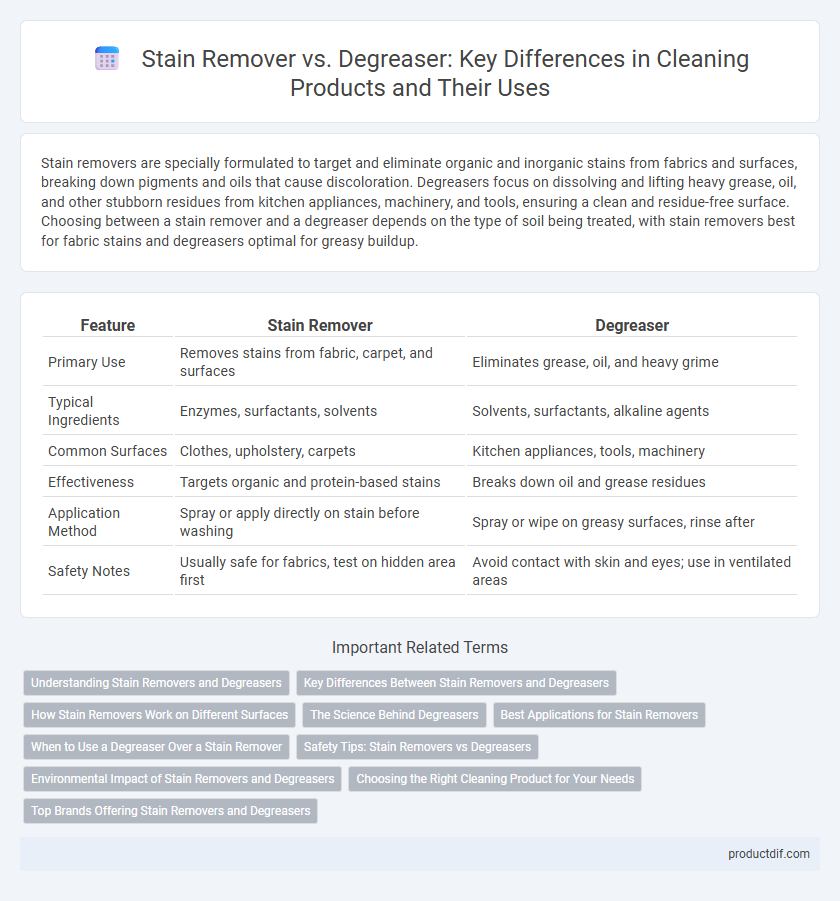Stain removers are specially formulated to target and eliminate organic and inorganic stains from fabrics and surfaces, breaking down pigments and oils that cause discoloration. Degreasers focus on dissolving and lifting heavy grease, oil, and other stubborn residues from kitchen appliances, machinery, and tools, ensuring a clean and residue-free surface. Choosing between a stain remover and a degreaser depends on the type of soil being treated, with stain removers best for fabric stains and degreasers optimal for greasy buildup.
Table of Comparison
| Feature | Stain Remover | Degreaser |
|---|---|---|
| Primary Use | Removes stains from fabric, carpet, and surfaces | Eliminates grease, oil, and heavy grime |
| Typical Ingredients | Enzymes, surfactants, solvents | Solvents, surfactants, alkaline agents |
| Common Surfaces | Clothes, upholstery, carpets | Kitchen appliances, tools, machinery |
| Effectiveness | Targets organic and protein-based stains | Breaks down oil and grease residues |
| Application Method | Spray or apply directly on stain before washing | Spray or wipe on greasy surfaces, rinse after |
| Safety Notes | Usually safe for fabrics, test on hidden area first | Avoid contact with skin and eyes; use in ventilated areas |
Understanding Stain Removers and Degreasers
Stain removers are specifically formulated to target and break down organic and inorganic stains such as wine, coffee, or ink on fabric and surfaces. Degreasers are powerful cleaning agents designed to dissolve and remove tough grease, oil, and grime primarily found in kitchens and industrial settings. Understanding the chemical composition and intended use of stain removers and degreasers ensures effective cleaning and prevents damage to materials.
Key Differences Between Stain Removers and Degreasers
Stain removers are formulated to break down and lift organic or ink-based stains from fabrics and surfaces, targeting substances like wine, coffee, or blood. Degreasers specialize in dissolving oily, greasy residues commonly found in kitchens and industrial environments, effectively cutting through tough grease on cookware, machinery, and tools. The key difference lies in their chemical composition and intended use: stain removers focus on pigment and protein-based marks, while degreasers employ stronger solvents and surfactants designed for lipid removal.
How Stain Removers Work on Different Surfaces
Stain removers target specific molecules in stains using enzymes or solvents that break down proteins, oils, or dyes, making them effective on fabrics, carpets, and upholstery without damaging fibers. They are formulated to work on delicate surfaces by neutralizing stains through chemical reactions that lift discoloration without harsh abrasion. Understanding the composition of the surface, such as porous textiles versus non-porous materials, is crucial to selecting the right stain remover for optimal cleaning results.
The Science Behind Degreasers
Degreasers work by breaking down oily and greasy substances through surfactants that emulsify and lift fats and oils from surfaces. Unlike stain removers, which primarily target specific pigments or residues, degreasers neutralize lipids by disrupting their molecular structure, facilitating easy removal with water. This process relies on chemical agents that penetrate and dissolve hydrophobic grease, making degreasers essential for heavy-duty cleaning tasks in kitchens and industrial environments.
Best Applications for Stain Removers
Stain removers are most effective on organic stains such as wine, coffee, blood, and grass, targeting protein-based and dye-based residues with enzymatic or chemical formulas. They work best on fabrics, upholstery, and carpets where precise spot treatment is needed without compromising the material's integrity. Unlike degreasers, which excel at breaking down oil and grease on hard surfaces, stain removers provide delicate yet powerful cleaning solutions tailored for textile and porous surface applications.
When to Use a Degreaser Over a Stain Remover
Degreasers are specifically formulated to break down oil, grease, and heavy-duty grime, making them ideal for kitchen surfaces, automotive parts, and industrial equipment where stubborn oily residues are common. Stain removers target dyes and organic stains on fabrics and carpets, and may not effectively cut through thick grease or oil buildup. Use a degreaser over a stain remover when tackling greasy spills or residues to ensure thorough cleaning and prevent lingering slick surfaces.
Safety Tips: Stain Removers vs Degreasers
When using stain removers and degreasers, always wear protective gloves and ensure proper ventilation to minimize skin irritation and inhalation of harmful fumes. Select products with non-toxic, biodegradable ingredients when possible to reduce environmental impact and health risks. Store both stain removers and degreasers out of reach of children and pets to prevent accidental ingestion or contact.
Environmental Impact of Stain Removers and Degreasers
Stain removers often contain enzymes and surfactants that break down organic materials but may include phosphates or solvents harmful to aquatic ecosystems. Degreasers typically use petroleum-based solvents or strong alkaline agents, posing higher risks of air and water pollution if not biodegradable. Choosing eco-friendly, biodegradable formulations reduces environmental impact by minimizing toxic residues and promoting faster natural degradation.
Choosing the Right Cleaning Product for Your Needs
Stain removers are specially formulated to break down and lift organic and inorganic stains from fabrics and surfaces, targeting pigments and discolorations for effective spot treatment. Degreasers contain powerful solvents designed to dissolve heavy grease, oils, and grime, making them ideal for kitchen surfaces, machinery, and automotive parts. Selecting the right product depends on the type of soil: use stain removers for fabric-related stains and degreasers for oily residues to ensure optimal cleaning results and surface safety.
Top Brands Offering Stain Removers and Degreasers
Top brands like OxiClean and Vanish lead the stain remover market with formulas targeting tough spots on fabrics, offering enzymes and oxygen boosters for effective stain elimination. In the degreaser category, companies such as Krud Kutter and Zep provide powerful solutions designed to break down grease and grime on kitchen surfaces, automotive parts, and industrial equipment. Consumers seeking high-performance cleaning products often rely on these established brands for their proven stain-fighting and grease-dissolving capabilities.
Stain remover vs Degreaser Infographic

 productdif.com
productdif.com